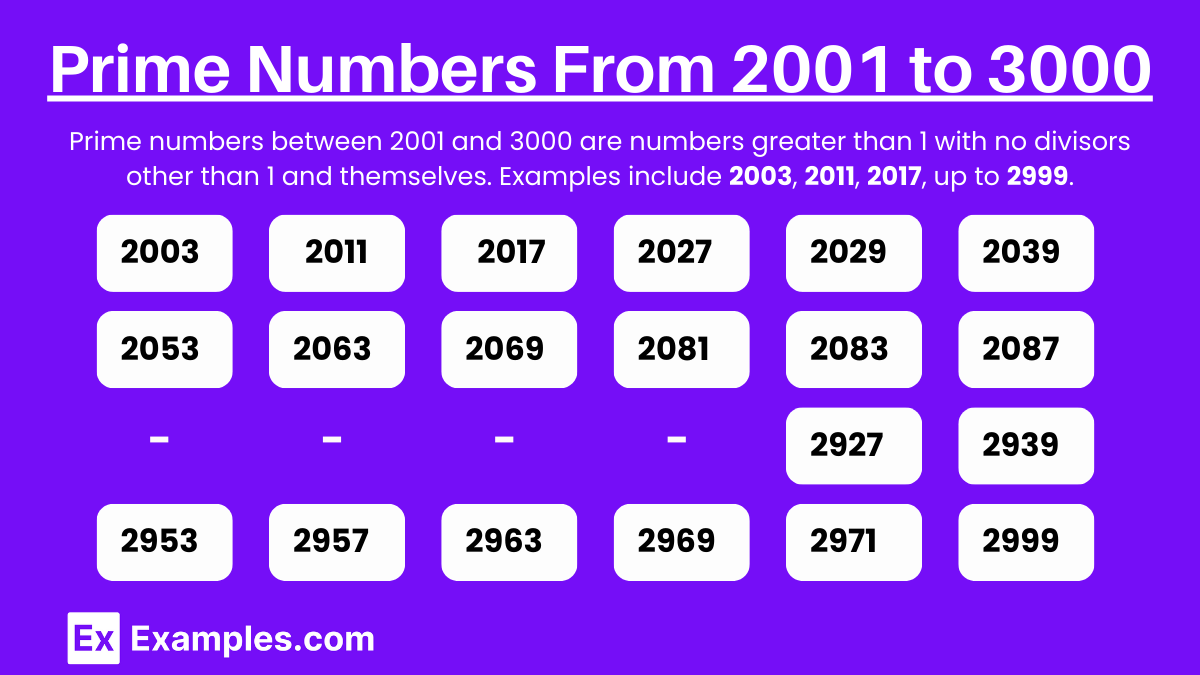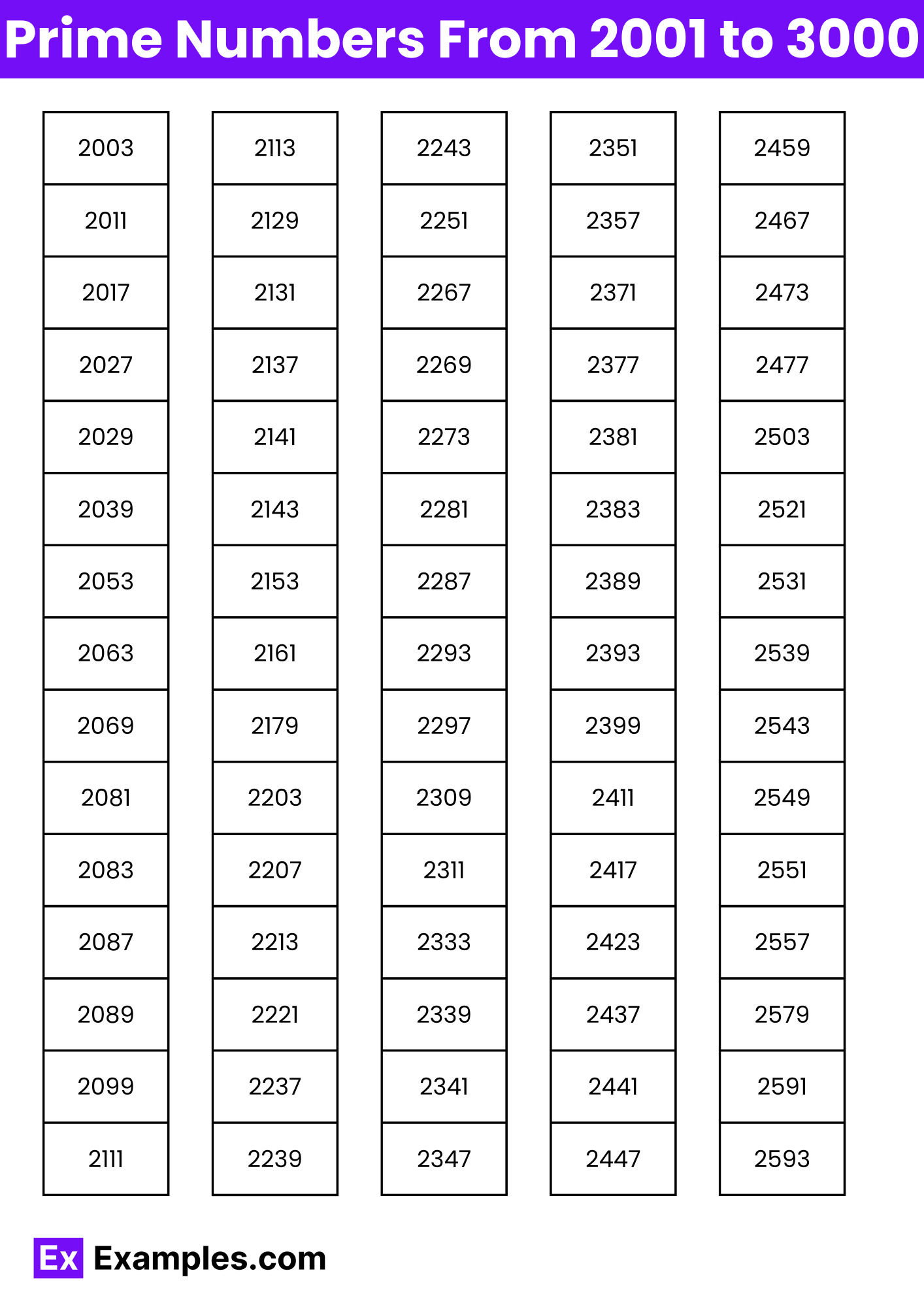Which of the following numbers is a prime number?
2027
2048
2056
2080


Prime numbers between 2001 and 3000 are natural numbers greater than 1 that have no positive divisors other than 1 and themselves, distinguishing them from composite numbers which have additional factors. These primes extend the sequence beyond the initial 2000, playing a crucial role in mathematics and algebra. Examples in this range include 2003, 2011, 2017, up to 2999, each maintaining the defining characteristic of having exactly two distinct positive divisors. Understanding these prime integers contributes to the broader study of number theory and the unique properties of prime numbers in higher numerical ranges.
Download List of Prime Numbers From 2001 to 3000 in Pdf

Download Prime Numbers From 2001 to 3000 in Pdf
| Prime Numbers | Prime Numbers |
|---|---|
| 2003 | 2063 |
| 2011 | 2069 |
| 2017 | 2081 |
| 2027 | 2083 |
| 2029 | 2087 |
| 2039 | 2089 |
| 2053 | 2099 |
| 2053 | 2111 |
| 2113 | 2137 |
| 2129 | 2141 |
| 2131 | 2143 |
| 2147 | 2153 |
| 2159 | 2179 |
| 2203 | 2213 |
| 2221 | 2237 |
| 2239 | 2243 |
| 2251 | 2267 |
| 2269 | 2273 |
| 2281 | 2287 |
| 2293 | 2297 |
| 2309 | 2311 |
| 2333 | 2339 |
| 2341 | 2347 |
| 2351 | 2357 |
| 2371 | 2377 |
| 2381 | 2383 |
| 2389 | 2393 |
| 2399 | 2411 |
| 2417 | 2423 |
| 2437 | 2441 |
| 2447 | 2459 |
| 2467 | 2473 |
| 2477 | 2503 |
| 2521 | 2531 |
| 2539 | 2543 |
| 2549 | 2551 |
| 2557 | 2579 |
| 2591 | 2593 |
| 2609 | 2617 |
| 2621 | 2633 |
| 2647 | 2657 |
| 2659 | 2663 |
| 2671 | 2677 |
| 2683 | 2687 |
| 2689 | 2693 |
| 2699 | 2707 |
| 2711 | 2713 |
| 2719 | 2729 |
| 2731 | 2741 |
| 2749 | 2753 |
| 2767 | 2777 |
| 2789 | 2791 |
| 2797 | 2801 |
| 2803 | 2819 |
| 2833 | 2837 |
| 2843 | 2851 |
| 2857 | 2861 |
| 2879 | 2887 |
| 2897 | 2903 |
| 2909 | 2917 |
| 2927 | 2939 |
| 2953 | 2957 |
| 2963 | 2969 |
| 2971 | 2999 |
The prime numbers from 2001 to 3000, totaling 135, are essential elements in the realm of mathematics, offering insights into number theory and various applications such as cryptography. These primes include significant examples like 2003, 2027, and 2999, each uniquely contributing to the structure and properties of natural numbers. Their distribution underscores the complexity and beauty of prime number theory, continuing to intrigue mathematicians and enthusiasts alike.
Text prompt
Add Tone
10 Examples of Public speaking
20 Examples of Gas lighting
Which of the following numbers is a prime number?
2027
2048
2056
2080
Identify the prime number from this list:
2144
2122
2130
2111
Which number is prime among these?
2233
2247
2251
2266
Find the prime number in this set:
2339
2350
2361
2374
Which of these numbers is a prime number?
2411
2420
2448
2455
Select the prime number from the following:
2517
2531
2544
2556
Which number is a prime number?
2617
2630
2651
2664
Find the prime number in the list:
2741
2764
2786
2802
Which of these is a prime number?
2901
2903
2916
2932
Select the prime number from the following:
2999
3000
2985
2992
Before you leave, take our quick quiz to enhance your learning!

